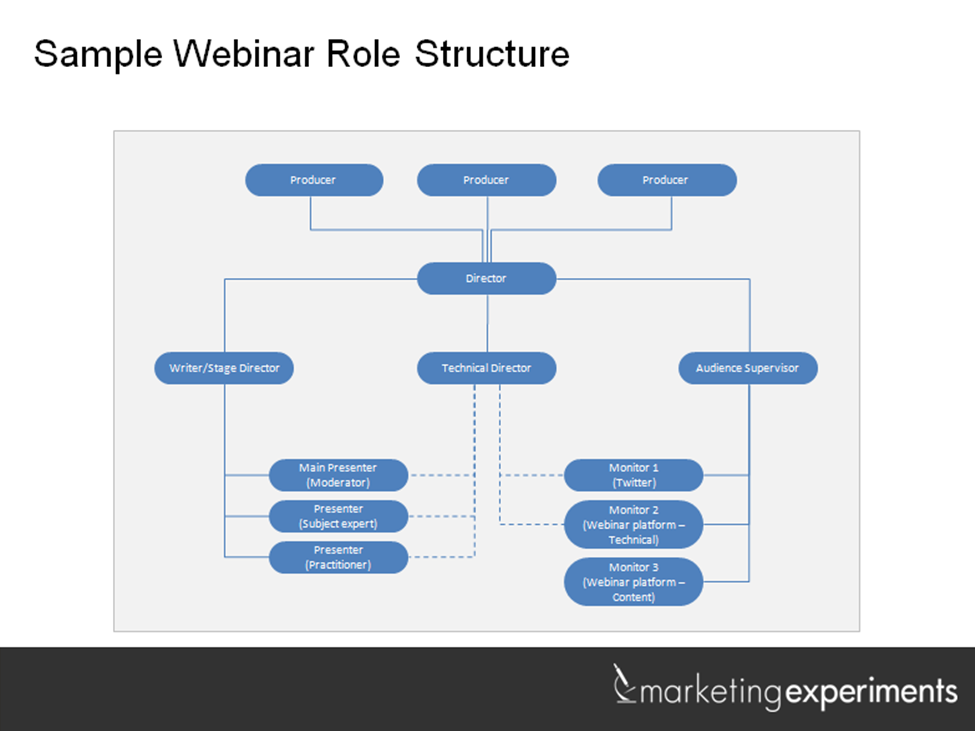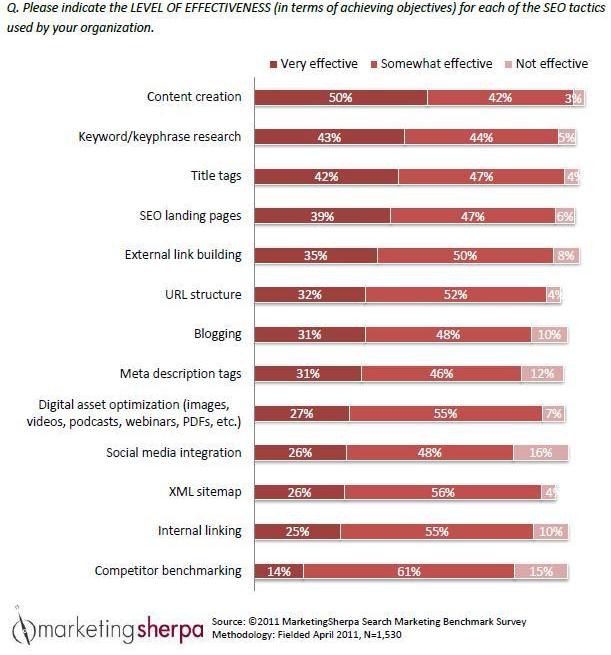B2B marketers are increasing their investments in inbound tactics. Don’t just take my word for it. When we surveyed 935 of your peers for the MarketingSherpa 2011 B2B Marketing Benchmark Report, 60% said they were increasing investment in virtual events and webinars.
But what does it take to produce an effective webinar? A virtual event that will grab people’s attention and encourage them to leap into your funnel, as opposed to check their email while you ramble on?
At MECLABS, we produce some pretty popular webinars. I’m not trying to brag about our crazy webinar skills. The truth is, we invest a lot of resources in these. And that’s why they’re good.
So when webinar director, Austin McCraw, presented me with an org chart of the roles that we fill during the average webinar, I thought it could be very useful to the MarketingSherpa audience.
Now, when I saw we invest a lot in these webinars, these are not full-time employees dedicated solely to webinars. Webinar director is not Austin’s official title. And on one webinar or another, I’ve filled every role we’re about to discuss. You will very likely have one person fill more than one role.
But I think this org chart may be helpful to you because it gives you an idea of all the bases you should consider covering for a successful, interactive webinar with your audience.
Producers
In Hollywood, the producer is the money man. The one investing in the film, but also ensuring it makes money (or, in Mel Brooks’ “The Producers,” loses money).
In the marketing world, the producers are likely marketing managers, product managers, and business leaders that fund the webinars with their marketing budgets, and seek to generate profitable leads or valuable lead nurturing from the webinars.
It is crucial to ensure producers are involved in the entire webinar process, so everyone is clear on the goal for the webinar and the value your company expects to derive from it.
Director
You don’t need Spielberg, but you do need one central decision maker. Webinars are live productions, and as with any live event, (even when it is virtual) things can and do go wrong. You need someone who is quick on their feet and has the guts to be able to call the tough shots. Your Internet connection died. The slides aren’t advancing. The audio isn’t working. What do you do? Quick, you have 12 seconds to decide before your audience starts dropping off the webinar.
Writer/Stage Director
A good webinar is filled with well-thought out content that guides your audience through a logical thought sequence, much like a film or story would. You need to not only create that content, but prep your presenters for exactly how to deliver it. Virtual stage blocking, if you will.
Technical Director
You can’t host a webinar without technology. And as with any technology, it helps to actually know how to use it. You’re far less likely to have a Skype chat pop-up that reveals company secrets live to the audience if you actually know what you’re doing and don’t have to ask “what does that red button do?”
Our setup for the MarketingExperiments Web clinic is quite complex, complete with a mixing board, handheld and wireless microphones, and an Apple computer running Final Cut Pro to capture the live audio for our Web clinic replays.
You don’t need to go to this level. But you do need to know, or have someone who knows, how to actually use the webinar platform.
Audience Supervisor
Sure, you could drone on for an hour about all the features and benefits of your product. Or, you could actually respect your audience (and capture their attention), by including them as much as possible in the webinar. That is, after all, the benefit to your audience of taking an hour from their busy day and actually attending a live event.
The audience supervisor not only tries to maximize interaction points with the audience, but also monitors the audience’s feedback and reactions to constantly make the course corrections needed to optimize the performance while the webinar is being conducted.
A good speaker naturally does this before a live audience, gauging the reaction – from boredom to engagement – and changing the presentation as she goes. This is harder, but not in possible, in a virtual event, so your presenters are going to need a little help and guidance.
Main Presenter
The main presenter is essentially a moderator. Someone who can act as an advocate for the audience. He’s Ed Sullivan, Johnny Carson, Oprah Winfrey, Terry Gross, Bill Maher, Ira Glass. The kind of person that can relate what a technical expert is saying to novice listeners.
Another important skill is the ability to tie disparate parts of the presentation together into a natural flow with well thought-out segues. And, with the audience supervisor’s help, tie in audience comments, questions, and other interaction.
All very naturally. All part of the flow. All part of the show.
Presenters
Your practitioners and subject matter experts are why people tune in to being with. But they’re not necessarily expert presenters. And that’s one reason why you have everybody else in this org chart. To support these guys…your well-coddled stars.
The main presenter may certainly well be one of your subject matter experts or practitioners, but it takes the right set of skills and the right personality to pull both roles off well.
Monitors
The monitors support the audience supervisor and, based on your resources, they all may be one and the same. They engage with your audience using virtual platforms – responding to questions, probing the audience for feedback and interaction, providing supplementary resources, and solving problems. We’ve found that the Q&A function in the webinar platform, along with a hashtag on Twitter, are good platforms for interacting with our audience.
You should also have a technical monitor making sure the audio and slides of the webinar are streaming well and actually working. It could be someone in a different room or even a different city. Your other monitors should pick up on this if they’re listening to audience feedback, but it never hurts to know something isn’t working before your audience starts complaining.
Related resources
Marketing Webinar Optimization: Five questions to ask yourself about webinars
New to B2B Webinars? Learn 6 steps for creating an effective webinar strategy
Free webinar, Wednesday, July 20 — Copywriting on Tight Deadlines: How ordinary marketers are achieving 200% gains with a step-by-step framework (educational funding provided by HubSpot)
Free webinar, Thursday, July 28 — How to create engaging content for successful lead generation













